Adorned in pastel blue smocks with smiles from ear-to-ear, it can be easy to spot a Seattle Children’s volunteer.
From the volunteers that do arts and crafts with patients in the playroom to those who deliver key items to patient rooms and refill coffee pots for medical staff, every volunteer at Seattle Children’s is significant in helping to keep the hospital running smoothly each day.
Just last year, volunteers donated over 120,000 hours of service, which highlights the commitment of the more than 500 individuals who serve Seattle Children’s every month.
In honor of National Volunteer Week, Seattle Children’s is showing gratitude to its volunteers by sharing the stories of six individuals who have generously donated their time to strengthen the organization’s mission to provide hope, care and cures to help every child live the healthiest and most fulfilling life possible.
Barbara Ford: Child Life volunteer
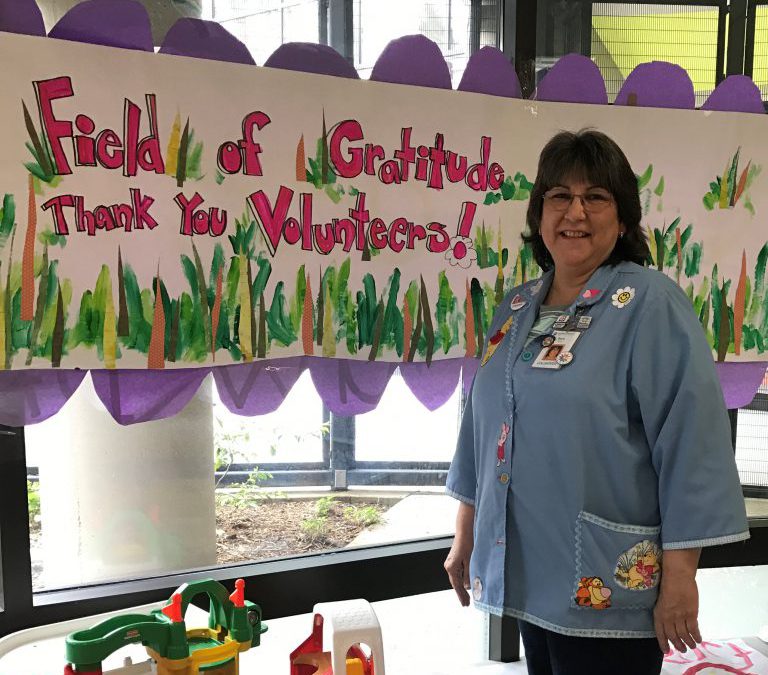 Barbara Ford confidently knows her way around the hospital, making her role as a Child Life volunteer simple when it comes to locating a patient’s room to deliver toys, books, or just to simply keep them company while their parent steps away.
Barbara Ford confidently knows her way around the hospital, making her role as a Child Life volunteer simple when it comes to locating a patient’s room to deliver toys, books, or just to simply keep them company while their parent steps away.
“I’ve been coming here for the past 22 years for my daughter, so it’s like a second home to me,” said Ford. “One day I decided — why not become a volunteer to give back?”
The youngest of Ford’s five children was diagnosed at birth with Aicardi syndrome, a rare neurological disorder, which resulted in numerous visits and long hospitals stays at Seattle Children’s over the years.
“My daughter Annie is a total-care patient, meaning she does not have the ability to function on her own,” said Ford. “She needs round-the-clock care which includes sleeping next to her every night just to make sure she’s OK.”
Ford feels fortunate to have a close-knit family who help her care for Annie while she volunteers.
“My family is a huge support,” said Ford. “They encourage me to volunteer because they know how much Seattle Children’s has done in caring for Annie.”
Ford’s volunteer shift starts in the inpatient playroom on most Thursday mornings. She and several other volunteers begin their shift by sanitizing toys and books so they’re clean and ready for patients to enjoy.
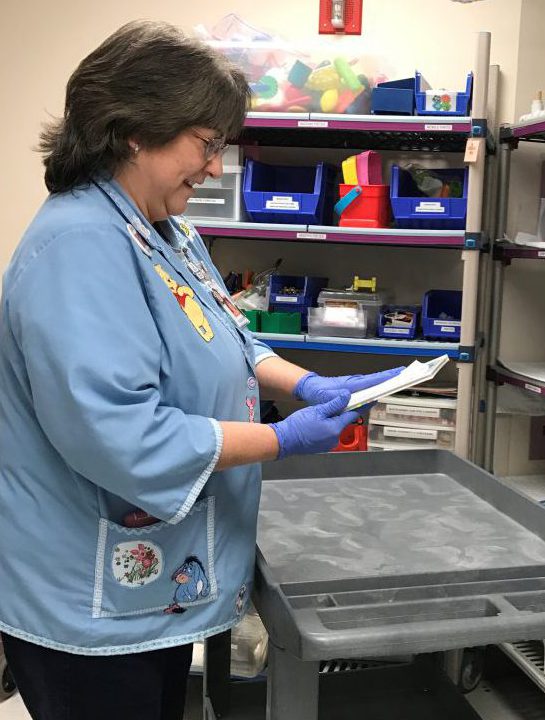 The next part of the shift involves visiting patient rooms, which gives some parents the opportunity to step away for a few minutes while a volunteer keeps their child company.
The next part of the shift involves visiting patient rooms, which gives some parents the opportunity to step away for a few minutes while a volunteer keeps their child company.
On some days, the room visits which are assigned to Ford include a baby or two.
“I love getting to hold babies,” said Ford. “Many of the babies I meet have medical conditions that require gentle handling. Having had experience holding Annie who was a very delicate baby, it has become second nature to me.”
Her experience holding babies isn’t the only valuable skill Ford offers as a volunteer. She understands the stress a parent can go through having a child at the hospital and knows how important it is to take a little break to unwind, even if it’s only for a few minutes.
“In a friendly way, I tell them to go grab a snack, coffee or anything that can help them to de-stress a bit,” said Ford. “I can speak from past and current experience on how taking a short break can make a world of a difference.”
At the end of the day, Ford finds inspiration from caring for Annie.
“Annie may not be able to communicate verbally, but she’s taught me and so many others how to love and care for someone unconditionally,” said Ford. “By volunteering, I’m able to spread her message to others.”
Abe Hersi: Messenger and front desk volunteer
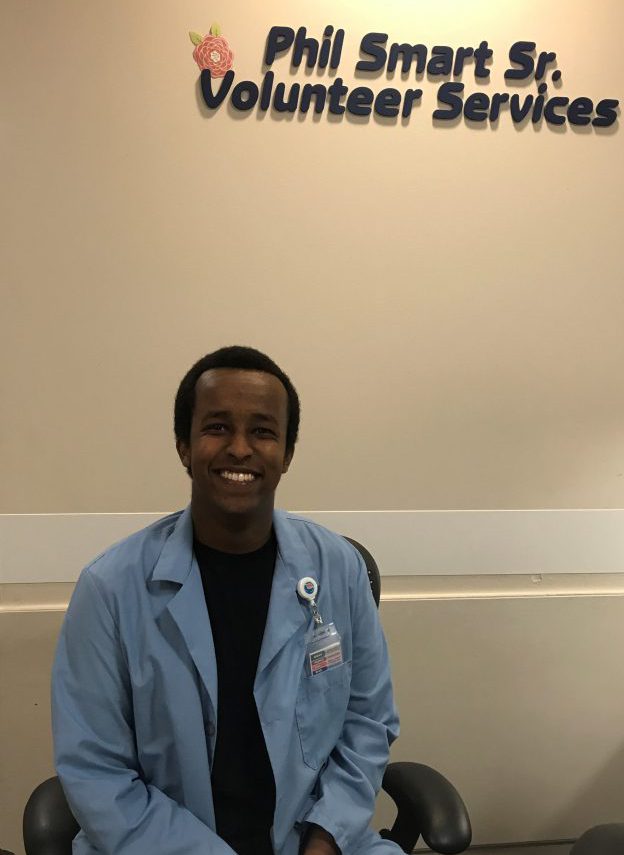 Having a busy class schedule doesn’t stop University of Washington student Abe Hersi from taking the time to volunteer at Seattle Children’s every Tuesday.
Having a busy class schedule doesn’t stop University of Washington student Abe Hersi from taking the time to volunteer at Seattle Children’s every Tuesday.
“When I first started college, I looked for opportunities where I could be immersed in a hospital environment because the medical field always interested me,” said Hersi. “When I found Seattle Children’s, I decided to go for it to see where the experience would take me.”
Hersi, now a junior majoring in molecular biology, has been inspired by his volunteer work — whether it be delivering a wheelchair to a patient’s room or collecting donations at the front desk of the volunteer office — each activity puts his career goals into perspective.
“My goal is to become a doctor,” said Hersi. “The experiences I’ve picked up as a volunteer have pulled me in the direction of pediatrics, which I feel really good about.”
Each week, Hersi looks forward to what he’ll be assigned to do during his shift.
“Some days I work on putting together welcome packets for patient families and other days I go to different floors of the hospital to clean stethoscopes — there’s never a dull moment,” he said.
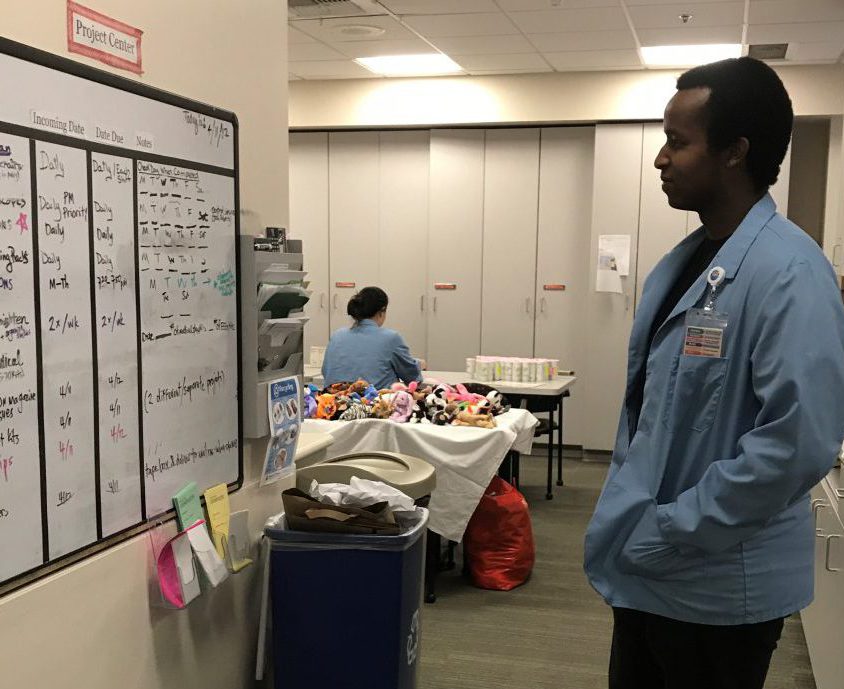 Being the youngest of seven children, Hersi values the importance of family.
Being the youngest of seven children, Hersi values the importance of family.
“My family means the world to me,” said Hersi. “That’s why I find the most rewarding part of my work as a volunteer is seeing joy on the faces of families when they leave the hospital to go home.”
Hersi has high hopes for getting into medical school within the next few years.
“Volunteering at the hospital gives me a glimpse into a future career as a doctor,” said Hersi. “I’m grateful to Seattle Children’s for giving me the opportunity to follow my passion.”
Mary and Theresa Nicholas: Office and Therapy Pool volunteers
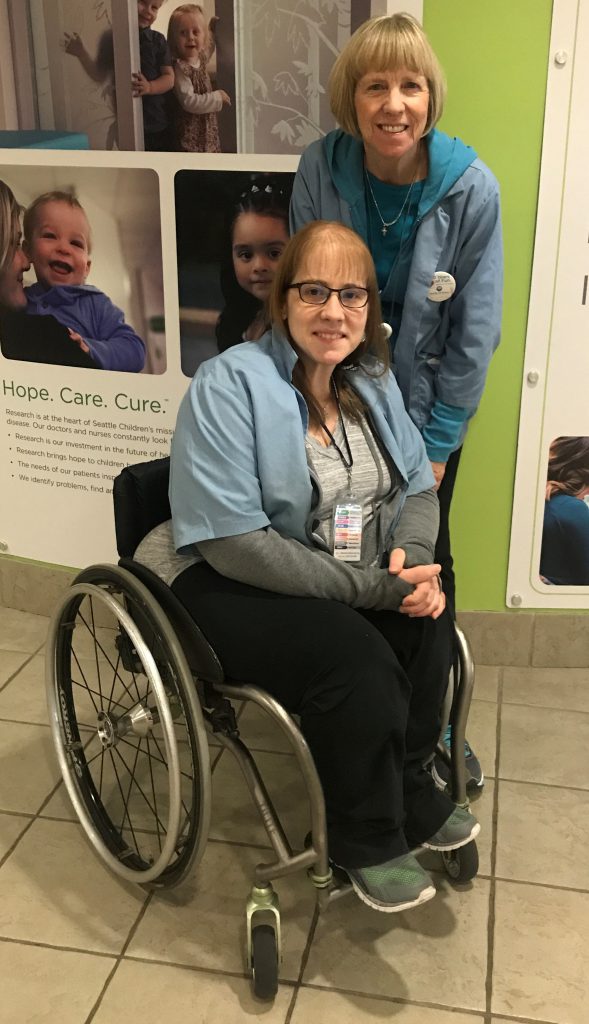 For Mary and her daughter Theresa Nicholas, volunteering at Seattle Children’s on Wednesdays is both a family bonding experience and a way to give back to a place they know well.
For Mary and her daughter Theresa Nicholas, volunteering at Seattle Children’s on Wednesdays is both a family bonding experience and a way to give back to a place they know well.
Theresa, a messenger and front desk volunteer in the volunteer office, was a patient at Seattle Children’s for 22 years.
“I was born with spina bifida, a birth defect which affected the way my spine developed,” said Theresa. “I spent a lot of time in and out of the hospital for surgeries and treatment. The staff at Seattle Children’s took such good care of not only me, but my mom as well.”
Mary would spend days, sometimes weeks, with Theresa at the hospital. These experiences would later influence her decision in becoming a volunteer after she retired from teaching physical education.
“When I first began 10 years ago, they recommended I volunteer in the therapy pool since I had experience as a lifeguard,” said Mary. “I start my shift by preparing toys and putting out towels for the group of patients scheduled to use the pool. Once they arrive, we’ll do a variety of fun pool activities like throwing a ball around or swimming laps back and forth.”
After volunteering at the pool for the first four years, Mary decided to try something a little different by providing help in the volunteer office. Currently, she splits her time between both roles so she can spend some time with Theresa.
“I love getting the chance to hang out with my mom,” said Theresa. “I think we complement each other nicely while working together in the office.”
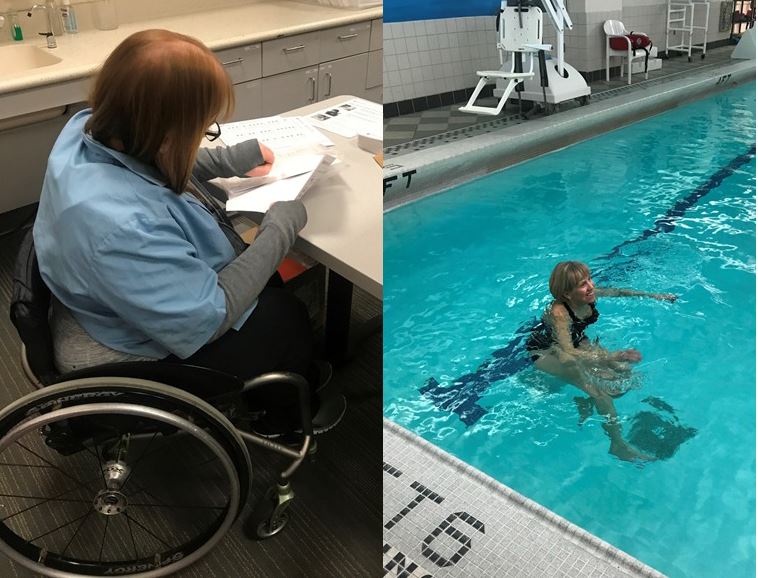 Theresa’s favorite part of volunteering is getting the opportunity to inspire patients who might have a medical condition similar to hers.
Theresa’s favorite part of volunteering is getting the opportunity to inspire patients who might have a medical condition similar to hers.
“There are times when I see a patient traveling around the halls in a wheelchair,” said Theresa. “When they see how confidently I move around in my wheelchair — especially when I’m delivering something as part of my messenger duties — I get a sense they feel uplifted knowing there’s someone out there who doesn’t let their physical disability hold them back.”
As a mother of four who’s now living in an empty nest, Mary cherishes the time she’s able to spend with each of her kids. With Theresa, volunteering has become a weekly tradition for the dynamic mother and daughter duo.
“I enjoy our time together,” said Mary. “It’s special we get to spend it in a place that remains near and dear to our hearts.”
Mike Port: Emergency Department volunteer
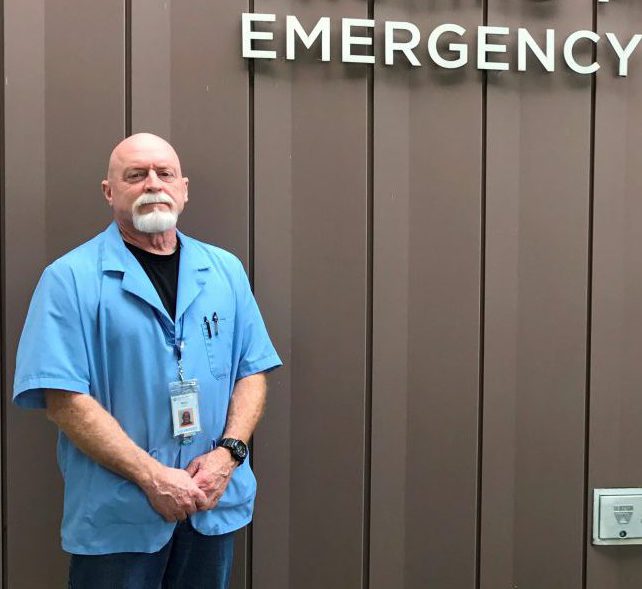 When Mike Port arrives at the hospital on his Harley motorcycle every Monday and Thursday, he’s fueled up and ready to take on the tasks needed in Seattle Children’s Emergency Department (ED).
When Mike Port arrives at the hospital on his Harley motorcycle every Monday and Thursday, he’s fueled up and ready to take on the tasks needed in Seattle Children’s Emergency Department (ED).
“I was a few years away from retirement and knew I wanted to volunteer somewhere to stay active,” said Port. “When I learned about the Seattle Children’s volunteer program from my wife’s friend, I decided to check it out.”
Initially unsure of what role he wanted to do, he started by volunteering in the ED.
With the ED operating in constant motion 24 hours a day, he begins each shift by refilling coffee pots for the busy medical staff. From then on, it’s about making sure essential items like gowns, gloves and masks are well stocked and items like IV pumps are moved to the proper areas of the department.
“I’m always ready for a challenge, which is why I chose the ED,” said Port. “I know I made the right decision because it’s been an incredibly gratifying experience ever since.”
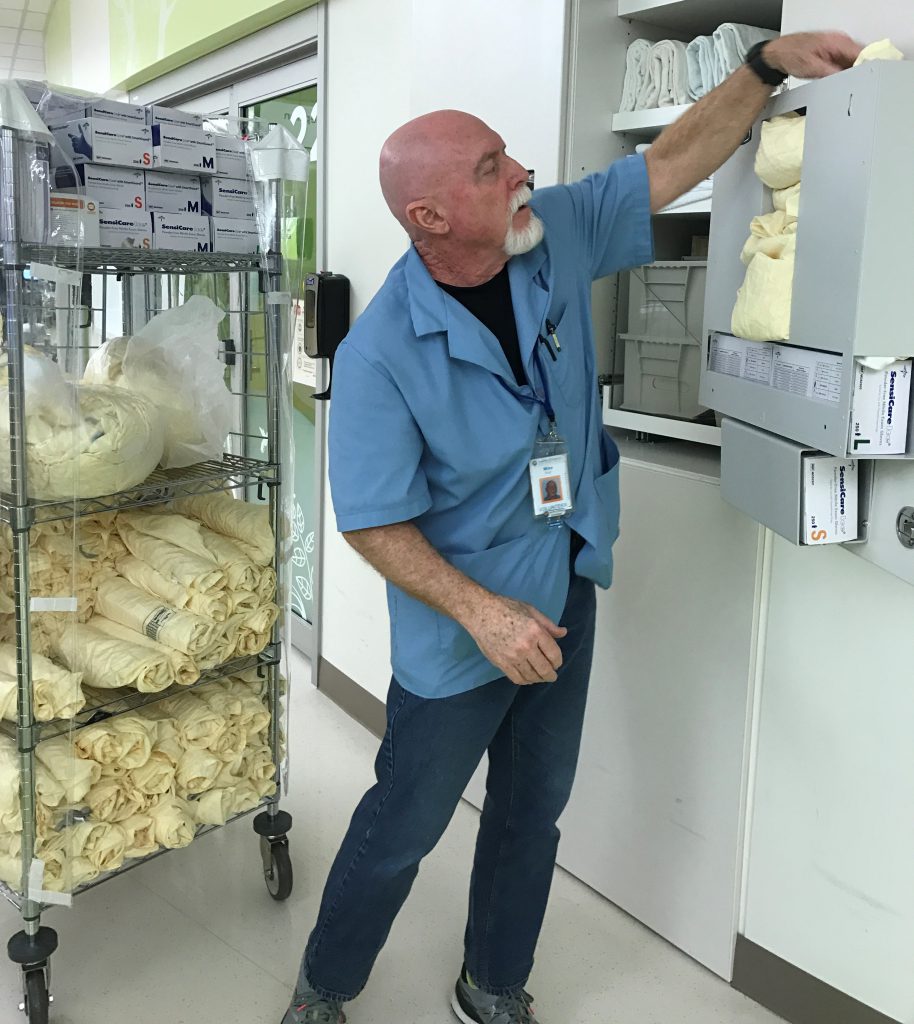 Port also gets the opportunity to interact with patients and families, which he says is his favorite part of volunteering.
Port also gets the opportunity to interact with patients and families, which he says is his favorite part of volunteering.
“Sometimes when I see a child who looks upset, I offer them some sort of distraction,” said Port. “That’s why I always carry a small container of bubbles in my pocket. It’s funny how something so little like blowing a few bubbles can make such a difference in a child’s mood.”
Having young grand children of his own, he finds enjoyment in making kids happy even in the most difficult situations.
“Volunteering in the ED can be tough, especially with some of the things you see,” said Port. “However, the good moments always outweigh the bad — and it feels very rewarding.”
Ashleigh Mueller: Physical Therapy volunteer
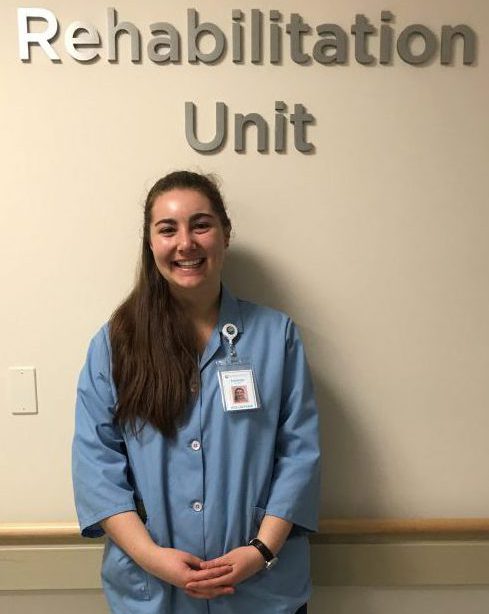 Watching young patients progress is what drives University of Washington student Ashleigh Mueller to volunteer at Seattle Children’s every Tuesday.
Watching young patients progress is what drives University of Washington student Ashleigh Mueller to volunteer at Seattle Children’s every Tuesday.
“For weeks at a time, I’ll see the same patients working with physical therapists in the gym where I perform volunteer duties,” said Mueller. “It’s amazing seeing some of them progress and the joy that it brings to their family.”
Mueller, a senior and biology major, has her sights set for a career in the medical field.
“I’d like to become either a physician assistant or physical therapist,” said Mueller. “I’m currently a certified nursing assistant, so I’m trying to gain as much experience as I possibly can to prepare for my future career.”
Mueller learned about the volunteer program offered at Seattle Children’s from friends at school.
“After getting the chance to work at a summer camp dedicated to people of all ages with complex medical conditions, I knew I wanted to volunteer at a place where I could broaden that experience even more — and that’s what brought me here,” said Mueller.
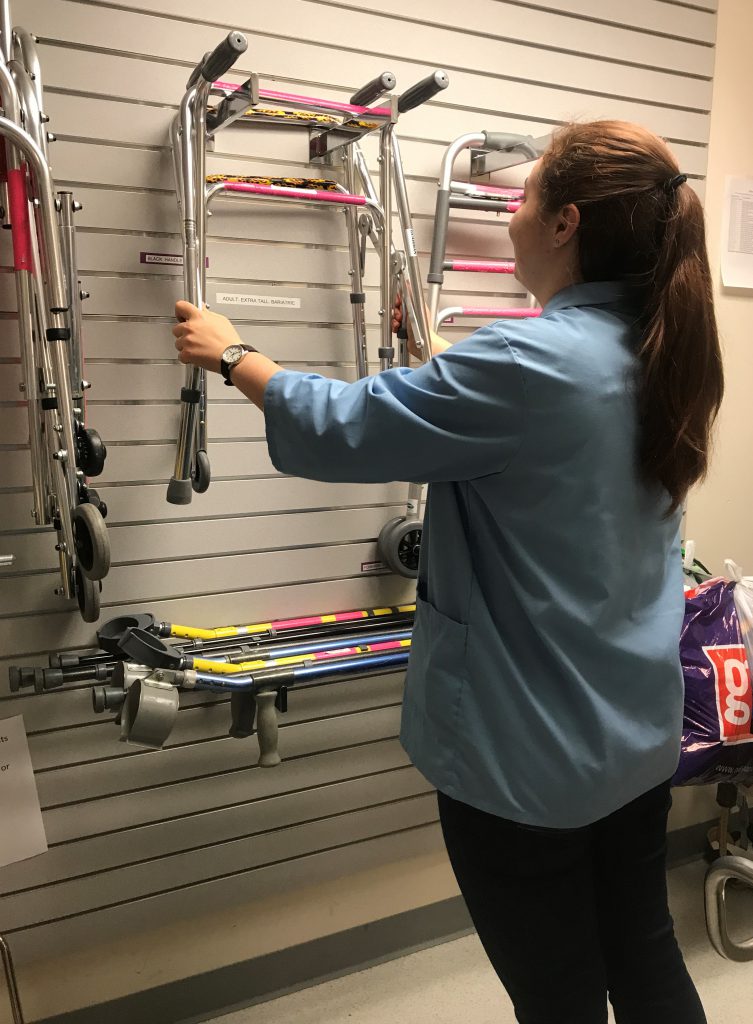 Mueller’s volunteer shifts involve keeping the gym in order and occasionally also assisting with patient rehabilitation activities.
Mueller’s volunteer shifts involve keeping the gym in order and occasionally also assisting with patient rehabilitation activities.
“My favorite part is the hands-on work,” said Mueller. “Sometimes I get to assist therapists in throwing a ball back and forth to a patient to help with their motor skills.”
Mueller is enthusiastic about what lies ahead in her career aspirations.
“I’m only a few months in, but I’ve enjoyed being here since day one,” said Mueller. “It’s awesome getting to be a part of something that makes a difference in the lives of children who need it most.”

